Menus
- top or flop?
- Kawasaki Z 750 B looks like a piece
- Comfortable, agile and stable
- "Best 750 British woman ever built in Japan"
- Kawasaki Z 750 B in detail
- Technical data Kawasaki Z 750 B
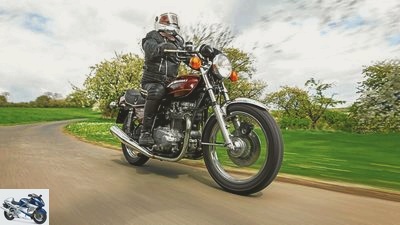
www.
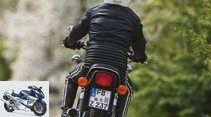
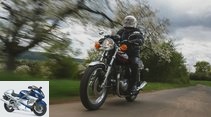
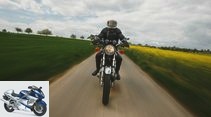
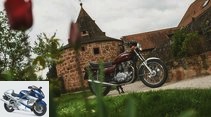
23 photos
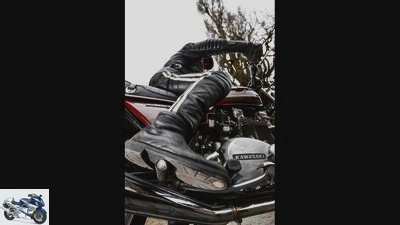
1/23
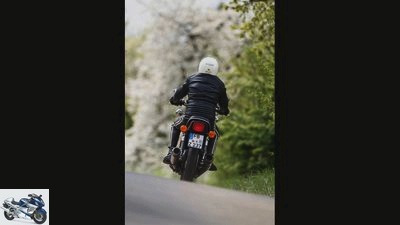
2/23
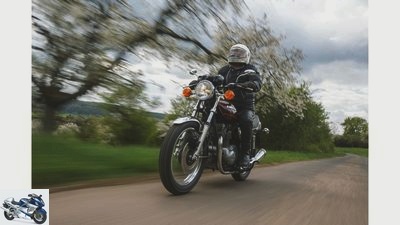
3/23
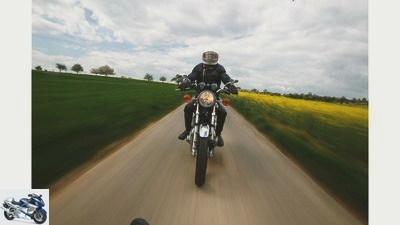
4/23
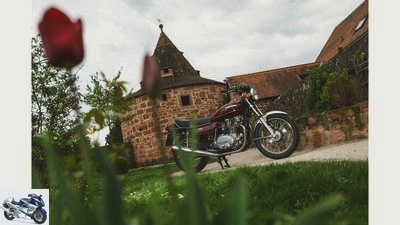
5/23

6/23
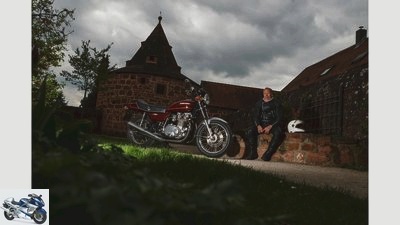
7/23
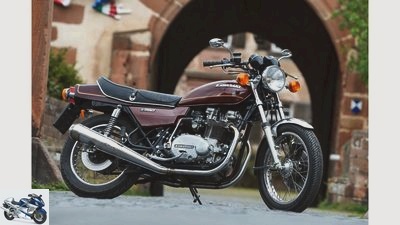
8/23
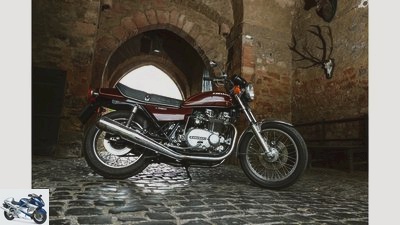
9/23
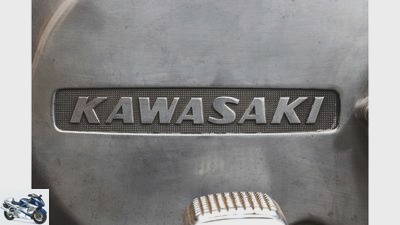
10/23
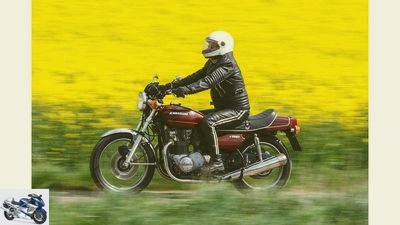
11/23

12/23
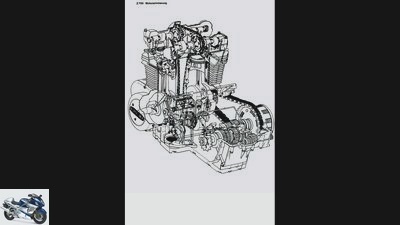
13/23
The crankshaft of the dohc parallel twin with two balancer shafts rotates “backwards”.
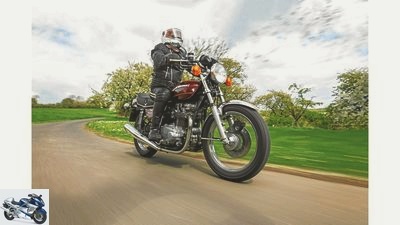
14/23
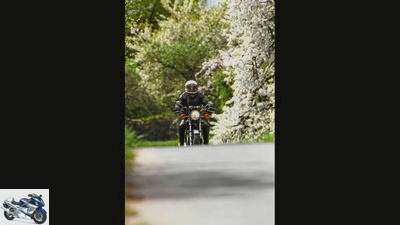
15/23
Thundering twin in blooming nature – the season could hardly start better.
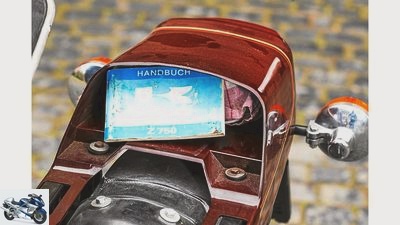
16/23
The Kawasaki demonstrates a practical sense with the small storage space under the rear apron. There is space for tools and a rain suit.
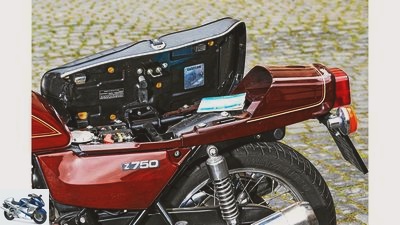
17/23
The air filter and battery are hidden under the folding bench. At this point, collectors are probably more interested in the flawless bench with its absolutely rust-free base plate.

18/23
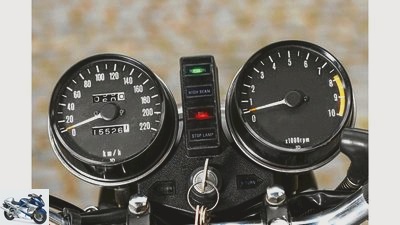
19/23
The cockpit represents the Japanese standard of the 1970s clearly and clearly.
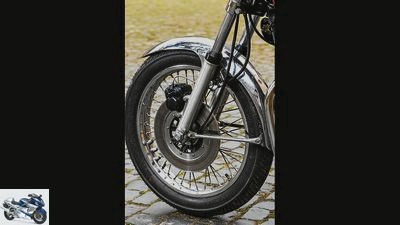
20/23
The front disc brakes moderately.
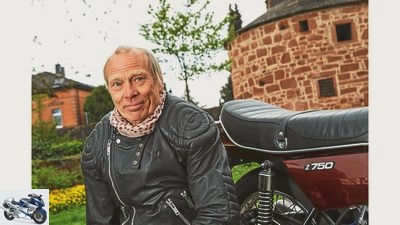
21/23
Manfred Ropke about the Kawasaki Z 750 B: For me, the two-cylinder Kawasaki is one of the most beautiful and at the same time most underrated motorcycles.
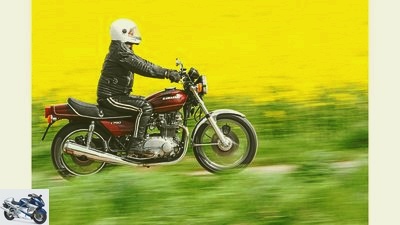
22/23
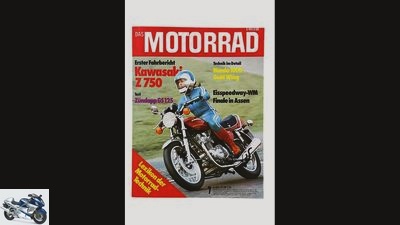
23/23
As luck would have it: the MOTORRAD issue with the first test as the initial spark for the ride with the Z 750 B..
On the move with the Kawasaki Z 750 B
top or flop?
Content of
To this day, the Kawasaki Z 750 B has had a hard time making its reputation as one of the big flops of the 1970s. The almost forgotten Japanese parallel twin was always overshadowed by the more powerful four-cylinder. High time for a rehabilitation attempt.
Not all of the stories you read from MOTORRAD Classic are based on strictly planned economies. Occasionally, the colleague coincidence also has a hand in it. Just recently, when for some inexplicable reason the MOTORRAD issue 7/1976 was on my desk with the Kawasaki Z 750 B on the title. Actually, I just wanted to take a quick look at the cover story. But after a few sentences I couldn’t get rid of the text – or rather: the Kawasaki – and so I devoured the test to the end. What Schermer-Franz had written at the time read like a single hymn of praise. And that for a motorcycle that, as a flop of the 1970s, I had long relegated to one of the back of my mind! A hasty judgment? So far, I haven’t had any real opportunities to revise this, as a Z 750 B is now one of the rarities.
Buy complete article
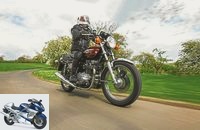
On the move with the Kawasaki Z 750 B
top or flop?
Kawasaki Z 750 B advertised for sale. And also fancy a story to bring the almost forgotten two-cylinder Kawa back into public awareness.
Kawasaki Z 750 B looks like a piece
“The machine looks great, doesn’t it?” The 74-year-old from Flensburg starts straight away with the persuasion. You can hardly contradict that, the Kawasaki Z 750 B painted in “Diamond Brown” looks like it is made from one piece. Sure, the relationship to the more powerful four-cylinder sister cannot be overlooked, but the parallel twin with its larger side covers, the wide seat and the angular rear apron has its own, harmonious lines.
The Kawasaki Z 750 B also offers technical features that once set it apart from its popular four-stroke sisters: the two-cylinder machine was not only the first Kawasaki with a rear disc brake, but also the first large-volume Kawa with a crank mechanism on slide bearings. Manfred Ropke has owned the 1977 B2 model for almost four years; he has brought it back to life after a 22-year slumber. The carburetors could no longer be saved, they gave way to two exchangeable copies of the same type. Rust in the tank required a thorough renovation with subsequent coating, otherwise only the rubber parts had to be replaced, the brakes overhauled, a new battery fitted and fresh oil filled in, then the Kawasaki ran again. The 15,500 kilometers shown in the speedometer are therefore credible. Much to my delight, which is hardly tarnished by the missing chrome rear fender. The part is in the garage because “the son thinks the machine is more beautiful without, just like we used to be”, Ropke smiles mischievously and presses the button. The pithy Bollern pulls the corners of his mouth up, the 3000 trouble-free kilometers since the resurrection must have been a lot of fun.
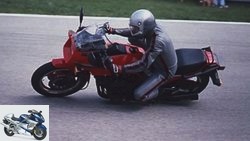
classic
Cult bike: Kawasaki Z 750 Turbo
The last of its kind
read more
Comfortable, agile and stable
A relaxed posture creates the best conditions for this. The positioning of the handlebars and footrests enables both tall and short riders to fatigue-free mile-away on the wide, lushly padded bench. Although the fork of the Kawasaki Z 750 B remained untouched after the long idle time, it spoils you with good responsiveness and surprisingly good damping, you can feel what the front wheel is doing.
In general, the handling of an almost 40-year-old motorcycle inspires confidence, even if the rear struts bounce back and forth from time to time. Franz found the shock absorbers too hard in his first test, but then he weighed a few pounds less. In any case, I like the neutral driving behavior of the Kawasaki Z 750 B, which can hardly be impressed by waves and potholes, but still dips into an inclined position without much effort. The steam hammer is amazingly agile for a 235 kilo chunk.
If you want to, the Kawa-Twin is still one of the quickest on country roads today. Provided that he has mastered the round driving style with a lot of momentum in the corners. The effect of the two disc brakes at the front and rear is not as impressive as Franz felt at the time, the standards have shifted enormously on this point. Which does not change the fact that Schermer’s judgment at the time about the driving behavior of the Kawa-Twin is still valid today, according to my impressions: “The Z 750 is very handy, willing to turn bends and also shows very good directional stability. Without giving too much advance praise, that should be the best chassis from Kawasaki so far. “
Sentences like this one in the “bible” of the motorcycle scene would actually have led to an increase in interest in the two-cylinder Kawa. But even biblical quotations fizzle out if at the same time devilishly fast four-cylinder lures. In fact, at that time Kawasaki saw a niche in the market that did not exist. In the mid-1970s, it wasn’t character that counted for motorcycles, but performance. In addition, the world in the “parallel universe” of that time was shaped by the misery and infirmity of the English motorcycle industry, the unshakable advocates of this nostalgic design principle – so poorly the image of Kawasaki‘s new two-cylinder engine. The high-tech attributes were of little use either, because in terms of top performance even the most modern parallel twin of its time could not work miracles.
"Best 750 British woman ever built in Japan"
Today there is an abundance of performance and perfection everywhere. However, what many motorcycles lack is character. One reason why I was so captivated by Schermer’s descriptions, he characterized the Kawasaki Z 750 B in the summary of his test as “the best British 750 ever built in Japan”.
An impression that Manfred Ropke’s Kawasaki conveys from the first few meters. Mechanically, the two-cylinder with little flywheel runs surprisingly smoothly, although in its silver aluminum housing, in addition to the crankshaft and the two camshafts, two chain-driven balance shafts also rotate. As soon as the clutch is engaged, the twin lets me feel its bull power, pushing gently but powerfully. With higher tours, pulsating vibrations are added, the intensity of which, however, never really pushes into the foreground.
What is more noticeable, on the other hand, is the desire of the square-designed twin (bore x stroke each 78 millimeters) for higher speeds, which are surprisingly easy on the crankshaft. Of course, these are not really necessary. Because even in fifth gear of the easily and precisely shiftable and ideally stepped transmission, the Kawasaki can be accelerated from the deepest depths of the engine speed range without hacking or doing other jokes.
A fairly relaxed drive, then, whose serenity is promptly transferred to the driver. In any case, I like the Kawa-Twin immensely, because it gives me powerful thrust exactly where I like it on winding country roads – namely right at the bottom. If you want something more precise, here you go: According to the factory, it should be just under 60 Newton meters at 3000 / min, with 7000 tours all 50 horses are fully assembled. Dry numerical values, which, however, only give you an idea of what to expect in the saddle of the Kawasaki on winding roads. Anyone who likes this extremely pleasant way of developing power should definitely get to know the Z 750 B better. The best chances for this are from June 13 to 16, 2014 at the “2. International Z 750 Twin Meeting “in Deulin-Hotton, Belgium, to which twin drivers from all over Europe are expected (for more information, see www.z750twin.de).
In any case, I won’t forget my ride on the two-cylinder Kawasaki anytime soon. With her harmonious, powerful nature, she showed me that the flaw of the flop clings to her completely undeservedly. It’s really a shame that my colleague Zufall didn’t help me realize this earlier.
Kawasaki Z 750 B in detail
The crankshaft of the dohc parallel twin with two balancer shafts rotates “backwards”.
(1976-1979); Price 1976: 6,500 marks
technology
When the four-cylinder euphoria reached its first climax, Kawasaki surprised the motorcycle world in 1976 with the Z 750 B, a parallel twin based on the quaint British model. Compared to the archaic constructions from the island, however, the completely redesigned Kawa two-cylinder was a real high-tech engine. As with the four-cylinder engines, two overhead camshafts actuate the two valves per cylinder via bucket tappets (but here with shims above). In order not to drive the piston speed into wear-inducing heights, the developers decided on a square stroke / bore ratio of 78 millimeters each, which is why the pistons up and down at 7800 rpm, the beginning of the red area, at a moderate 20.28 meters per second whiz off. In addition, two chain-driven balancer shafts rotating in opposite directions to the crankshaft take care of eliminating the design-related vibrations of a parallel twin.
In an effort to achieve smoother running, the engineers of the 750 two-cylinder also opted for the vibration-optimized design of a fully slide-bearing crank drive – the first in a large-volume Kawa four-stroke. The reward for the effort: a drive with a bang that impresses less with its maximum output of 50 hp at 7000 rpm, but much more with just under 60 Newton meters of torque at just 3000 tours. A very elastic engine that can be driven very lazily, even though the five gears engage easily and precisely.
Purchase check
The starter clutch and the cylinder head gasket in particular have emerged as the real weak points of the Z 750 B models. However, replacements are readily available. But not the original exhaust system, which consists of one piece on each side. In the event of defects, the manifold behind the interference pipe should be sawed off in order to be able to mount replica silencers more easily. A good, original tank, the seat or the side covers are also searched for longer nowadays, while you can switch to components of the four-cylinder models for brakes and even the swing arm. With an almost 40-year-old motorcycle, there is no need to point out the risk of typical damage to the stand. Probably due to a maintenance error with dramatic consequences: If the timing chain of the Kawasaki Z 750 B is retightened with the valve cover removed, the engine will definitely be damaged! Reason: After the valve cover has been installed, the chain is too tight because it also has a slide bar.
market
The supply of Kawasaki Z 750 B is scarce, even for rundown, halfway drivable restoration objects you have to invest around 1500 euros. Beautiful, neat Kawasaki Twins cost from 3000 euros upwards, with the sound barrier currently being around 4500 euros. Significantly higher price demands can hardly be realized even for top models, especially since Kawasaki’s parallel twin is currently less sought after by originality fanatics. At the moment it is more screwdrivers who are interested in a Kawasaki Z 750 B – as a great basis for contemporary cafe racer conversions.
history
In the Z 750 B models, the B1 / B2 types differ from the last two model years B3 / B4. Those have a modified alternator and crankshaft, as well as a modified timing chain tensioner. In addition, the brake caliper is attached behind the fork dip tube.
1981 to 1984: When the soft chopper wave spilled over to Europe, Kawasaki had the right motor on the shelf in the form of the high-torque parallel twin. The LTD model was then knitted around this with the usual chopper ingredients, which sold much better than the B models. From 1983 even with a toothed belt to the rear wheel. Price: 7500 Mark (1982)
Internet
Under www.z750twin.de Interested parties and owners of the Kawa two-cylinder will find very competent information and support. One great forum with many pictures that really make you want to see the Z 750 Twins!
Technical data Kawasaki Z 750 B




23 photos
Pictures: On the move with the Kawasaki Z 750 B
To home page
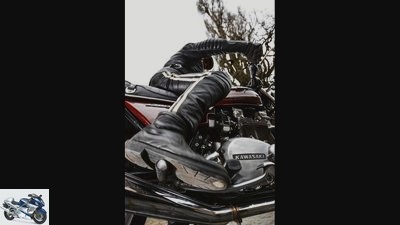
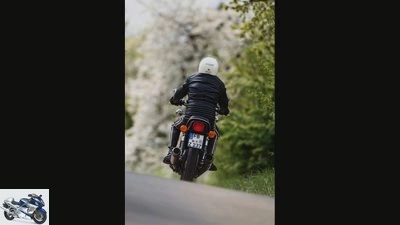
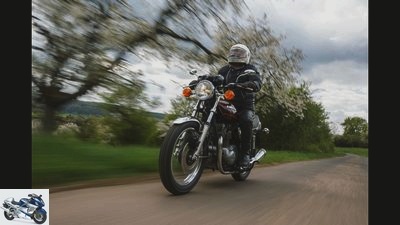
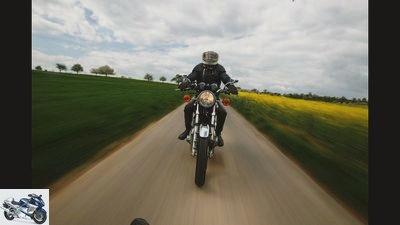
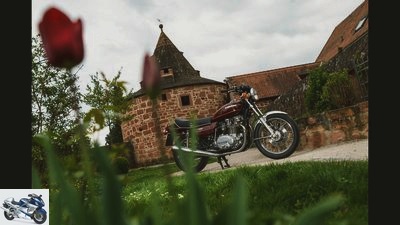
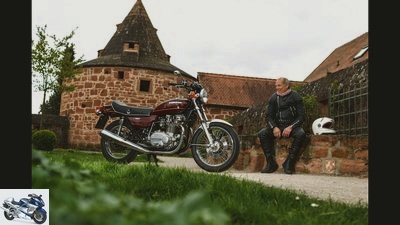
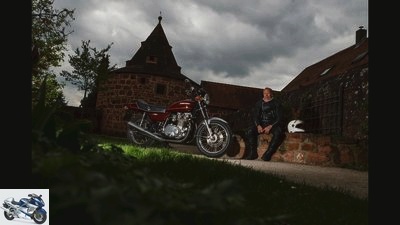
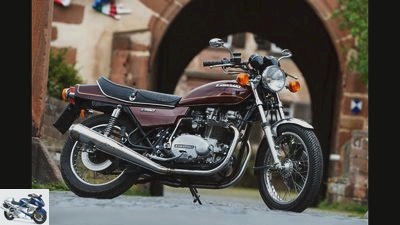
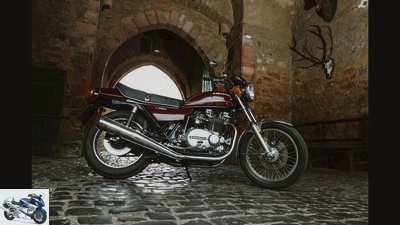
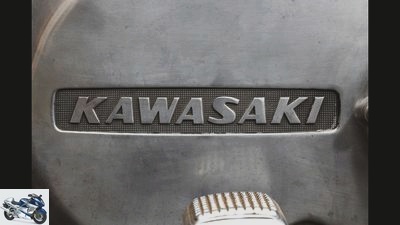
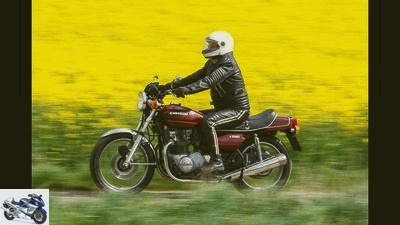
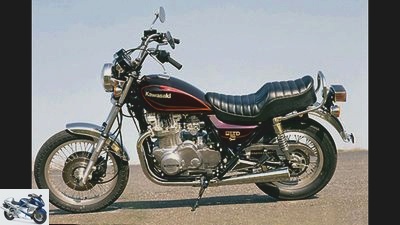
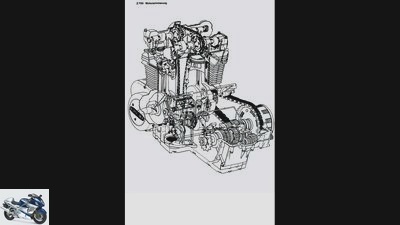
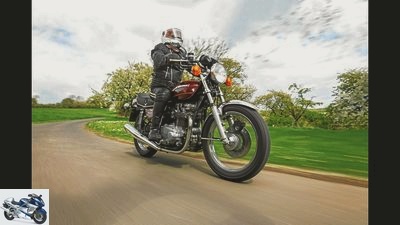
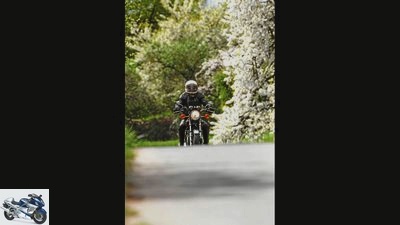
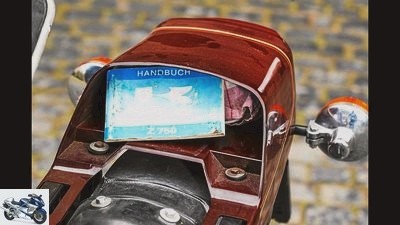
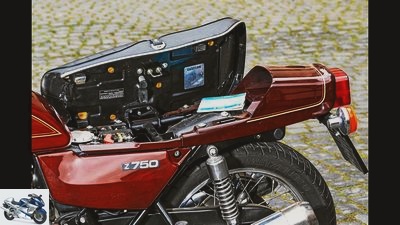


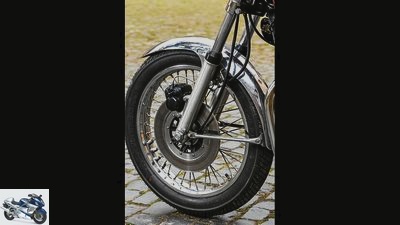
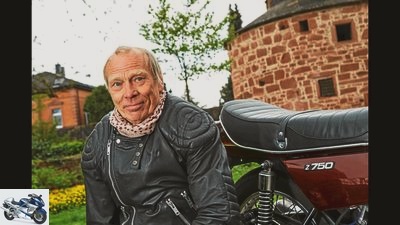
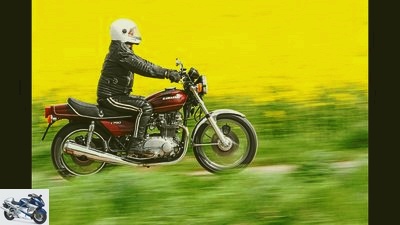
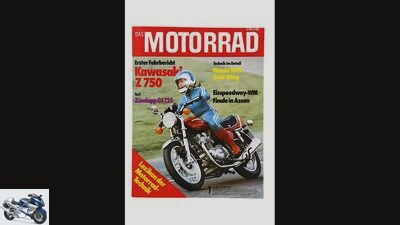
opinion
Manfred Ropke and his Kawasaki Z 750 B.
about the Kawasaki Z 750:
For me, the two-cylinder Kawasaki is one of the most beautiful and at the same time underrated motorcycles. The power from the cellar fits perfectly on winding country roads, as does the relaxed seating position. In addition, the Kawasaki Z 750 B drives frugally, pleasantly handy and trustworthy.
Related articles
-
Top test: Kawasaki Z 1000 Special Edition
www. 29 pictures www. 1/29 Radical, conspicuous and extremely strong, that must be a Z somehow, they probably thought …
-
Kawasaki Z1 and Kawasaki Z 900 RS
27 pictures 1/27 On the move with the Kawasaki Z1 and the Kawasaki Z 900 RS. 2/27 They curve so similarly …
-
First driving report of the Kawasaki GPZ 900 R (MOTORRAD 1-1984)
Archive 26 pictures Archive 1/26 Light, strong and fast was the formula for the Kawasaki superbike of the 1980s, the GP Z 900 R. Archive 2/26 According to …
-
BMW R 90 S, Kawasaki 900 Z1, Laverda 1000 3C Big Bikes
fact 30 pictures fact 1/30 Big-Bike classic from the 70s – pure fascination. Kawasaki 900 Z1, Laverda 1000 3C and BMW R 90 S from MOTORRAD Classic …
-
Kawasaki premiere: Kawasaki ZX-6R The 636 ninja from Kawasaki Content of traction control, two power modes, ABS – the 600 series are …
-
Final: 25 years of the Kawasaki GPZ 900 R
Artist Final: 25 years of the Kawasaki GPZ 900 R Fire under the bum It opened a new era: strong, fast, stable. The GPZ 900 R, Kawasaki’s first ninja with…
-
Honda CB 1000 R, Kawasaki Z 1000 SE, Yamaha FZ1 in the test
www. 48 photos www. 1/48 On the MOTORRAD test tracks in southern France, Honda’s CB 1000 R and Yamaha’s FZ1 are ready to test…
-
On the move with Kawasaki GPZ 900 R and Yamaha FJ 1100
fact 39 photos fact 1/39 Hurry with a while, always slowly with the young horses – sayings like these were definitely not up for debate when the new,…
-
Art Top-Test Kawasaki ZZR 1400 The time machine Welcome to the future. The ZZR 1400 is said to be the first production bike in the world with 200 hp …
-
Jahn Top-Test Kawasaki ZX-12R ZX-12Air With its 175 HP engine, Kawasaki’s green racer bridges distances like in flight and shifts …